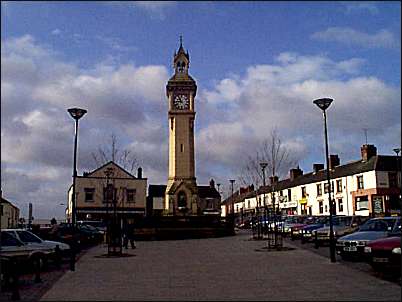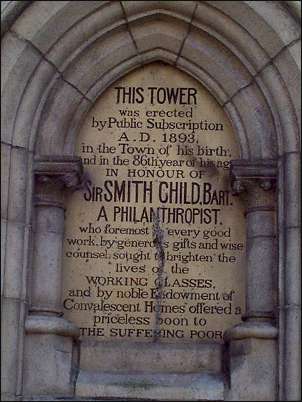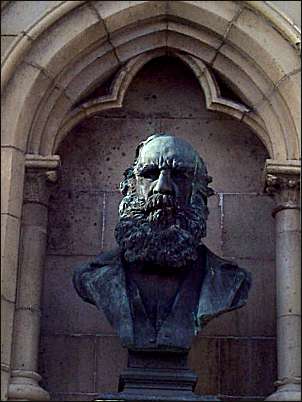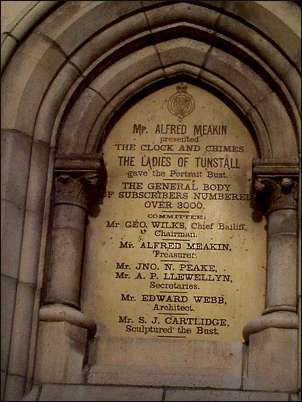|
Smith Child:
Sir Smith Child:
"He contributed annually to the Staffordshire Infirmary, served as
president and vice-president of its general management committee and
was elected a patron in 1895. In 1877 he built and endowed the Smith
Child ward, originally intended for incurable patients but
eventually opened as a children’s hospital. Two years earlier he had
founded the North Staffordshire Incurables Fund, for sending .
patients on holiday. He also. supported, in Tunstall, the local
Nursing Society and the Samaritan Society, and at Longton the
Cottage Hospital.
His benefactions
extended to other fields. He supported the Tunstall Choral Society;
the Victoria Institute, Tunstall, was built largely as a result of
his efforts and support and accommodated, at various times, a
museum, an art school, a technical school, a high school for girls,
a library and a reading room. Nor were his benefactions confined to
Tunstall. He supported the establishment of the Wedgwood Institute,
Burslem, gave £200 to the North Staffordshire Chamber of Commerce to
encourage the teaching of Spanish and Portuguese, the languages of
the expanding pottery markets in South America, and £1,000 towards
the establishment of a girls’ industrial school at Lichfield."
Source: People of the Potteries

Tower Square,
Tunstall
The tower erected in honour
of Sir Smith Child
Another
principal landed Proprietor in Tunstall is Smith Child, Esq., of
Newfield, an acting Magistrate of the County, who inherits the
estates of the Baddeleys, his ancestors on the female side, who have
been seated here for four centuries, at least, and where his
paternal grandfather, Admiral Smith Child, (whose mother was Mary
Baddeley,) died in 1813, at the advanced age of 83.
The
Newfield and other estates belonging to Mr. Thomas Baddeley, were
settled by him upon the marriage of his nephew, Captain
(afterwards Admiral) Child, with his cousin Margaret Roylance,
daughter of Mr. Thomas Roylance, of Townhouse, in Audley, in the
year 1764; and by the death of their eldest surviving' son, in his
father's life-time, these estates descended to his son, the
present proprietor, during his infancy.
Admiral Child entered the service in 1747, under the auspices of
Earl Gower, and as the nautical disciple of Lord Anson. He first
went to sea in the Chester, commanded by Sir Richard Spry ;
afterwards he entered the Devonshire, Captain Matthew Buckle ;
then into the Unicorn, and cruised in the Mediterranean, where he
received notice of having obtained his commission, and was ordered
to England ; he was then appointed Junior Lieutenant in the
Princess Royal, commanded by Sir Charles Saunders. He served at
the sieges of Pondicherry and Louisbourg, and commanded the Europe
in the two actions off the Chesapeake, in 1781, with such credit
as enabled him to obtain preferment for most of her officers.
The following year his
eldest son, Thomas, (a youth of great intrepidity and promise,)
perished in the unfortunate Ville de Paris. In 1795, Captain Child
took the command of the Commerce de Marseilles, mounting 128 guns,
which sailed on a secret expedition with one thousand troops on
board, besides five hundred seamen, and stores and provisions for
four months ; but she was found not to be sea worthy, and was
obliged to be brought back to port after being a few weeks only at
sea, to the very great disappointment of her commander ; as he often
mentioned in after-life. Captain Child attained his flag on
Valentine's Day, 1799.
He
was, during some time previously, the regulating officer of the
impress service at Liverpool, and received the honorary freedom of
that Borough. After his advancement to the flag, he was not employed
in actual service, but resided in Newcastle-under-Lyme for some
years ; and, as an honorary member of that Corporation, he was very
heartily greeted by a brother Admiral, his late Majesty King William
IV., then Duke of Clarence, when he, with the Prince Regent
(afterwards George IV.) visited Staffordshire, in 1806.

THIS TOWER
was erected
by Public Subscription
A. D. 1893
in the Town of his birth
and in the 86th year of his age
IN HONOUR OF
SIR
SMITH CHILD
BART
A PHILANTHROPIST
who foremost by every good
work by generous gifts and wise
counsel sought to brighten the
lives of the
WORKING CLASSES
and by noble Endowment of
Convalescent Homes offered a
priceless boon to
THE SUFFERING POOR
The family of Child
is said to be of Worcestershire extraction, but the Admiral's
immediate ancestors, for several generations, had been seated in the
Parish of Audley in this County, where they possessed considerable
property, which was mostly dissipated by Smith Child, the Admiral's
father, who was a man of polished manners, but wasteful in his
habits. Once, during a visit to Scotland, (where he went on
mercantile business,) he was introduced to and entertained by the
Duke of Hamilton, whom he accompanied in one of his hunting
excursions ( such as are described in Sir Walter Scott's Waverley),
and being in that country during the expedition of the ill-fated
Charles Stuart, in 1745, he was twice arrested, after the defeat of
the rebel forces, on suspicion of being the Pretender, to whom he
bore a strong resemblance. He travelled from Scotland in company
with Lord Glenorchy, who advised him to bring his son up to the
Navy, and introduced him to Lord Anson, the Circumnavigator, at that
time one of the Lords of the Admiralty, under whose patronage he
commenced his career, as we have already stated.
Source: Ward "The Borough of
Stoke-upon-Trent" 1843

Mr S J Cartlidge
sculptured
this bust of Sir Smith Child

Subscribers to the
tower

|
![]()
![]()
![]()